Are you curious about the world of edible mushrooms? Well, you’re in luck! In this article, we’ll dive into the different types of edible mushrooms and their unique characteristics. From the commonly known portobello to the elusive morel, we’ll explore the variety of flavors, textures, and health benefits that these delicious fungi have to offer. Whether you’re a seasoned mushroom enthusiast or a newcomer to the world of fungi, this guide to the types of edible mushrooms is sure to expand your culinary horizons. So, let’s get started!
As you explore the world of edible mushrooms, you’ll quickly discover the wide range of flavors and textures available. From the mild, earthy taste of button mushrooms to the richer, nuttier flavors of shiitake and oyster mushrooms, there is a wide variety of edible mushrooms for everyone.
In addition, edible mushrooms are a great source of vitamins and minerals, making them a nutritious and tasty addition to any meal. For the adventurous eater, there are a variety of edible mushrooms available, such as shiitake, morel, and porcini. Each of these mushrooms has a unique flavor that can add complexity and depth to any dish.
Many of these edible mushrooms are also known for their medicinal properties, so you can enjoy not only the taste but the potential health benefits as well.
No matter what type of edible mushrooms you choose, you’ll find that they can be cooked in a variety of ways. From stir-fries and soups to risotto and pasta dishes, mushrooms are incredibly versatile and can be used in a variety of recipes. By learning about the different types of edible mushrooms, you can create delicious and nutritious meals that you and your family will love.
A Selection of Edible Mushrooms and Their Potential Health Benefits
At The Supermarket
White Button Mushrooms
White button mushrooms (Agaricus bisporus) are one of the most popular and widely consumed edible mushrooms in the world. They are a type of white, fleshy mushroom with a mild flavor. They are used in a variety of dishes.
Button mushrooms are low in calories, fat, and sodium, and are a good source of dietary fiber, vitamins, and minerals. Button mushrooms are native to North America, Europe, and Asia, and can be cultivated or wild-harvested. They are typically found in the produce section of grocery stores, and can also be found canned or dried in some stores.
Button mushrooms have a short shelf life, so it is best to store them in the refrigerator and use them within a few days of purchase.
Button mushrooms are easy to add to your diet. They are very versatile and can be used in a variety of dishes. Button mushrooms can be used to add flavor and texture to many dishes. They can be eaten raw or cooked and added to soups, sauces, stews, salads, and stir-fries. They can also be grilled, sautéed, roasted, or baked.
Button mushrooms are an excellent source of nutrition. They are a good source of dietary fiber, vitamins B and D, potassium, phosphorus, and selenium. They also contain antioxidants, which can help to reduce inflammation, boost the immune system, and protect against certain diseases.
Crimini Mushrooms
Crimini mushrooms, also known as “baby bellas”, are a type of cultivated edible mushroom with a deep brown color, meaty texture, and rich flavor. They are a great addition to many savory dishes, adding a robust and earthy flavor.
Crimini mushrooms are a more mature stage of white button mushrooms. They have a larger, more mature cap than white button mushrooms, and are typically darker in color. They have a meatier texture and a more robust flavor than their smaller counterparts.
Crimini mushrooms are often used in many dishes, from soups and stews to pasta sauces. They can be cooked in a variety of ways, including sautéed, grilled, roasted, and even fried. They also make a great addition to pizzas, salads, and sandwiches. When purchasing Crimini mushrooms, look for mushrooms that are firm, plump, and dry. Avoid mushrooms that are slimy, cracked, or discolored. Keep in mind that Crimini mushrooms will continue to darken over time, so it’s best to use them soon after purchasing.
Crimini mushrooms are an excellent source of several vitamins and minerals. They are rich in Vitamin B3, which is important for energy production, and Vitamin B5, which is important for metabolizing fats and carbohydrates. They are also a good source of dietary fiber, which helps promote healthy digestion.
Portabella Mushrooms
Portabella mushrooms, also known as portobello mushrooms, are large, meaty, and widely popular edible mushrooms. They are the mature stage of white button mushrooms. Portabella mushrooms have a dark brown, almost black color, and a firm texture. They have a rich, earthy flavor and a slightly chewy consistency.
They are an excellent source of protein and fiber and are a great option for a healthy diet. Nutritionally, portabella mushrooms are packed with vitamins and minerals. They are a good source of vitamin B3, vitamin B12, copper, potassium, and selenium. They also contain some essential amino acids, such as tryptophan and lysine. In addition, they are low in fat and calories, making them an ideal food for healthy eating.
Portabella mushrooms are incredibly versatile and can be used in a variety of dishes. They can be grilled, roasted, sautéed, or even used in pizza or pasta dishes. Their unique flavor and texture make them the perfect addition to any meal.
In terms of sustainability, portabella mushrooms are an excellent choice. They are grown in a controlled environment and do not require fertilizers or pesticides. This makes them an environmentally friendly option too.
Shiitake Mushrooms
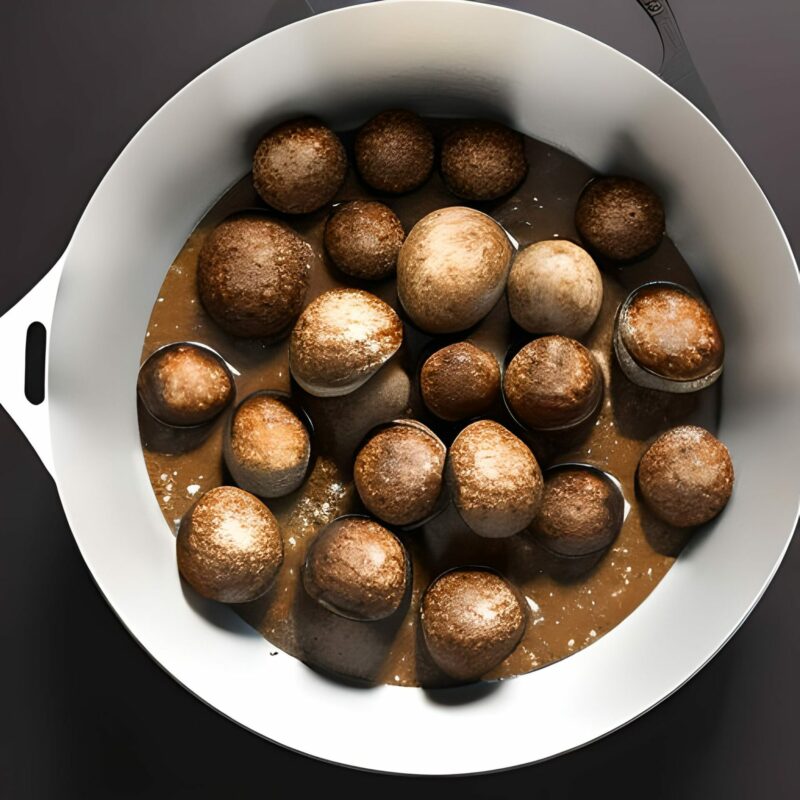
Shiitake mushrooms are one of the most popular and widely consumed mushrooms in the world. Often referred to as the “king of mushrooms” in Asian cultures, shiitake mushrooms are praised for their distinct flavor and medicinal properties.
Native to East Asia, shiitake mushrooms are now cultivated and consumed around the world. Shiitake mushrooms can be eaten raw, cooked, dried, or powdered.
When cooked, shiitake mushrooms have a distinct smoky-earthy flavor that makes them a favorite among chefs. Dried shiitake mushrooms have an even more intense flavor and are often used as a seasoning or garnish.
Many chefs and home cooks also appreciate the meaty texture of shiitake mushrooms, which makes them a great addition to soups, stews, stir-fries, and other dishes.
Shiitake mushrooms are also well known for their health benefits. They contain several vitamins and minerals, including B vitamins, zinc, selenium, and copper.
Shiitake mushrooms are also a source of dietary fiber and protein, and they contain a compound called eritadenine that may help reduce cholesterol levels. Additionally, some studies suggest that shiitake mushrooms may have anticancer and anti-inflammatory properties.
When purchasing shiitake mushrooms, look for mushrooms that are firm and dry with a pleasant woodsy aroma. Fresh shiitake mushrooms can be stored in the refrigerator for up to five days. Dried shiitake mushrooms should be stored in an airtight container in a cool, dark place for up to one year.
Oyster Mushrooms

Oyster mushrooms (Pleurotus sp.) have a wide array of culinary applications. Native to North America, Europe, and Asia, these mushrooms are unique in that they grow in clusters on decaying wood, making them easily identifiable. They are also highly sought after for their mild, slightly sweet flavor and firm, meaty texture.
Oyster mushrooms are not as readily available at the supermarket due to their delicacy and short shelf life. They are more commonly found locally and sold at farmer’s markets.
Oyster mushrooms have been used for centuries in traditional Chinese medicine as a natural remedy for various ailments, including respiratory problems and hypertension. Their popularity as a health food has only grown in recent years, as they are high in essential nutrients such as B vitamins, antioxidants, and minerals such as zinc and selenium. Oyster mushrooms are also a great source of dietary fiber, which can help to support digestive health.
In terms of culinary uses, oyster mushrooms are incredibly versatile. They can be cooked in stir-fries, added to soups, or even used as a meat replacement in certain dishes. Their mild, slightly sweet flavor and firm texture make them a great addition to any recipe, and they are incredibly easy to prepare.
Oyster mushrooms are also incredibly easy to cultivate at home. They can be easily grown on a variety of materials such as sawdust, straw, or wood chips. Or you can choose to purchase a kit that is ready to fruit and you can have fresh mushrooms in 10-14 days.
Lion’s Mane Mushrooms
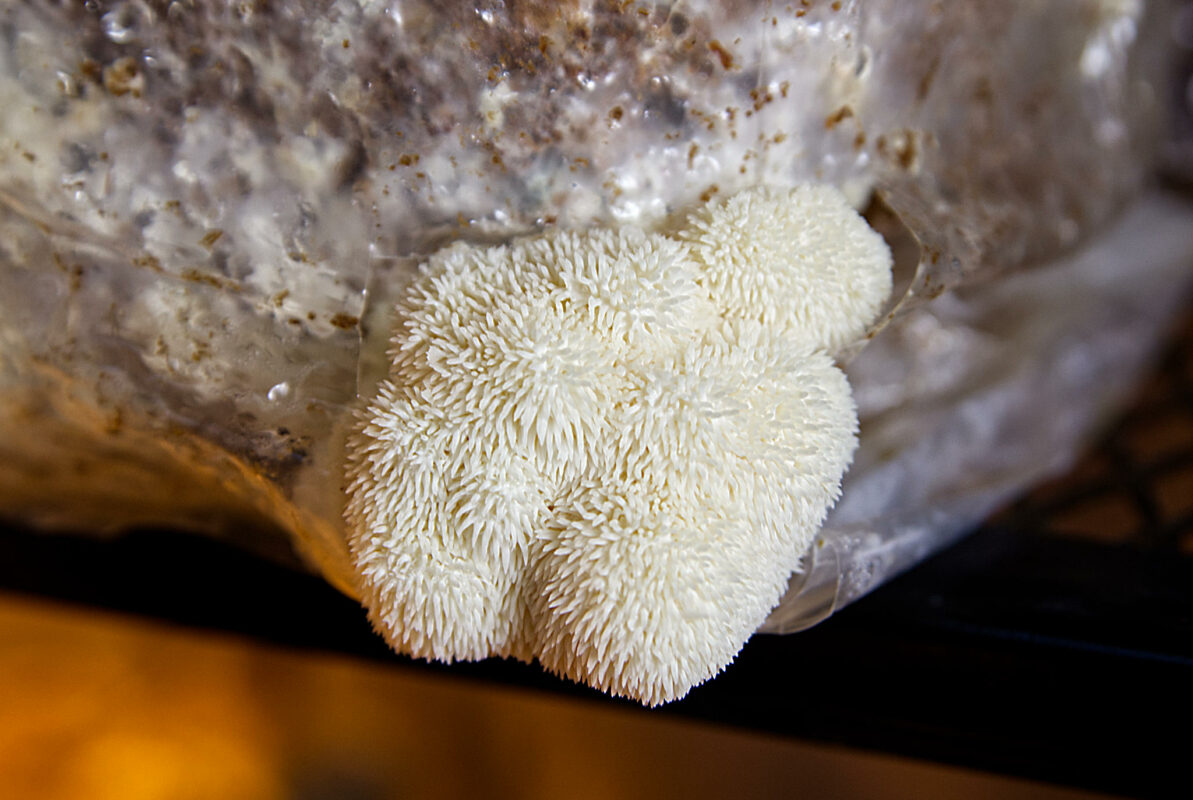
Lion’s Mane mushrooms (Hericium erinaceus) are another type of mushroom that is much more likely to be found at the local farmer’s market than in the supermarket. They are native to North America, Europe, and Asia. This species can also be found growing wild since it is native to North America.
The lion’s mane mushroom is highly sought after for its culinary and medicinal properties. The Lion’s Mane mushroom is easily recognizable due to its unique shape and texture. The mushroom has long cascading spines that resemble a mane of a lion, hence its name. It has a white color and a fleshy texture.
Lion’s mane is highly valued for its medicinal properties. It is believed to have anti-inflammatory, anti-oxidative, anti-diabetic, and anti-cancer properties, making it a popular choice for alternative medicines. It is known to boost the immune system, reduce cholesterol, improve cognitive function, and even treat neurological diseases such as Alzheimer’s and dementia.
The Lion’s Mane mushroom is also popular among chefs for its unique flavor and texture. It is often used as an ingredient in soups, sauces, and stir-fries. It is known to have a delicate, seafood-like flavor and a chewy texture that pairs well with other ingredients.
Lion’s Mane mushrooms are relatively easy to cultivate. The mushroom is usually grown on hardwood logs, such as oak and maple. It is generally grown outdoors, but it can also be cultivated indoors with the right conditions.
Types of Mushrooms You Can Forage
Now let’s look at the different edible mushrooms that experienced foragers can find growing in the wild.
A word of caution is required here. Never eat any mushrooms unless you are 100% sure of the identification. Get a good field guide or enlist the help of a local expert to help you identify them. Some mushrooms are extremely toxic and they can kill you if you make a mistake. If you aren’t sure you can identify mushrooms in the wild, stick with varieties you find offered in stores or farmer’s markets.
Morel (Morchella sp.)
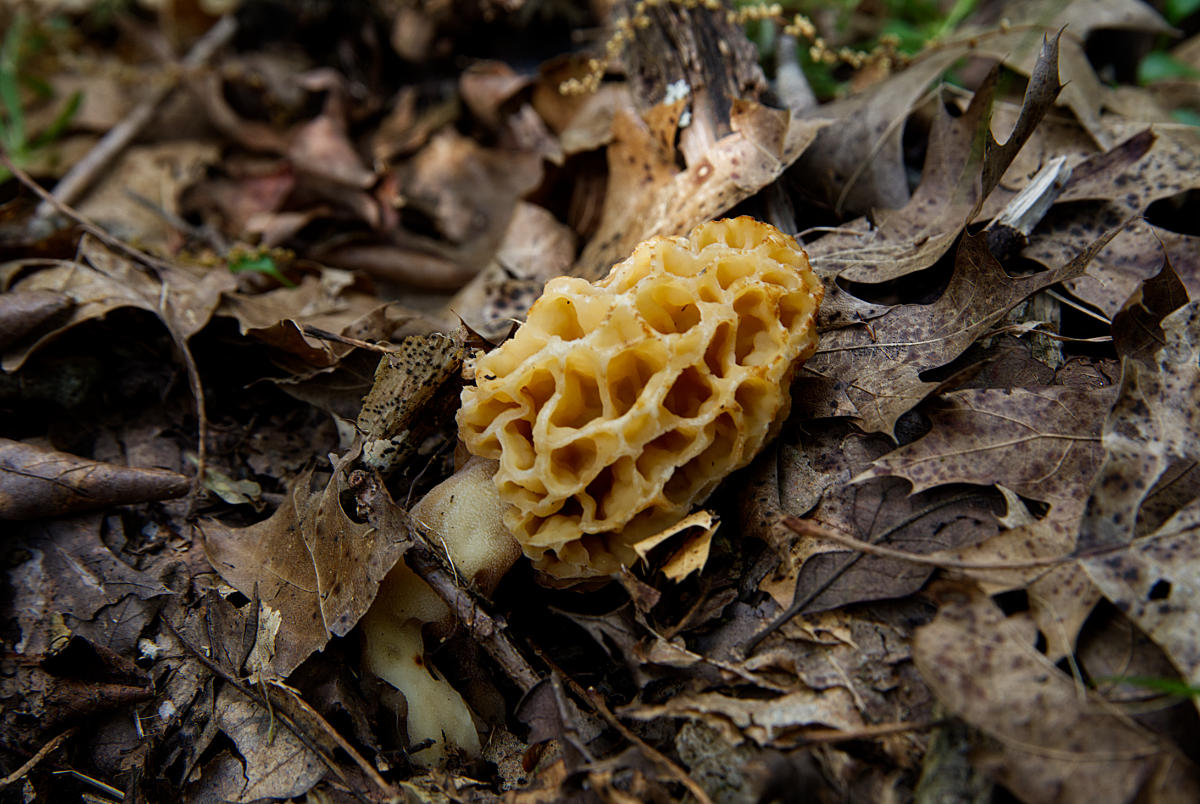
Morel mushrooms are some of the most sought-after and delicious edible mushrooms in the world. They are highly sought after by chefs and food enthusiasts alike due to their unique flavor, texture, and appearance.
Each spring an army of morel hunters enters the forests of North America hunting the elusive morel mushroom. These mushrooms are so prized that they can bring a premium price. I have seen them listed for as much as $45 per pound. When a forager finds a patch of morel mushrooms they will guard the secrecy of the location against even the most trusted friends.
Morels are a type of wild mushroom that can be found growing in the wild all over the world, but they are especially popular in North America and Europe.
Morels are easily recognizable due to their distinctive honeycomb-like appearance. They range in size from 1-4 inches in length and can be either conical or irregularly shaped. The color of morels can vary from a light tan to dark brown, depending on the species and the environment they are growing.
Morels can be found in wooded areas, meadows, river banks, and even in some suburban yards. They typically appear in the spring but can be found in some regions during other parts of the year as well. Morels grow in a variety of soils, ranging from loamy to sandy, and can be found in soil that is wet or dry.
There are two main types of morels: the yellow morel (Morchella esculenta) and the black morel (Morchella elata). The yellow morel is the most common type and has a yellow-brown cap and white stem. The black morel can be identified by its dark brown to black cap and tan to dark brown stem. Both types of morels are edible, but the yellow morel is generally considered to be the tastier of the two.
Morels can be consumed fresh when cooked or dried and saved for later consumption. They can be used in a variety of dishes such as soups, sauces, and pasta dishes. When cooking morels, it is important to note that they have a strong, earthy flavor that can be overpowering. To bring out their flavor, morels should be cooked for at least 10 minutes.
Morels are a great source of nutrition and are high in protein, vitamins, minerals, and antioxidants. They are also low in calories and fat, making them a great choice for those looking to add some variety and nutrition to their diet.
Chanterelle
Chanterelle mushrooms are highly sought after and found in many parts of the world. They have a distinctive funnel shape and bright yellow-orange color and are renowned for their unique aroma and flavor. Chanterelles are considered a delicacy and are often used in gourmet recipes.
There are several different types of Chanterelle mushrooms, the most common being the golden trumpet Chanterelle (Cantharellus cibarius) and the white Chanterelle (Cantharellus subalbidus). The golden Chanterelle is considered to be the most flavorful, with a fruity, apricot-like scent and a distinctively nutty taste. The white Chanterelle is milder in flavor, with a light, earthy aroma.
Chanterelles can be found in temperate climates in North America, Europe, Asia, and Australia. They prefer moist, shady areas with plenty of organic matter and are particularly fond of coniferous forests, but can also be found in hardwood forests. Chanterelles can be found in early spring and late fall, and are often found in large clusters.
Chanterelles are versatile mushrooms and can be used in a variety of recipes. They can be sautéed, fried, or boiled. They are also often used in soups, stews, and sauces. Chanterelles are also popular in many European cuisines.
When harvesting Chanterelles, it’s important to be aware of their environment and be sure to leave some of the mushrooms to spread their spores for the next harvest. It’s also important to be aware of any potential contaminants that may be present in the area. Chanterelles should be carefully inspected for any signs of damage or insect infestations before being eaten.
Oyster Mushrooms
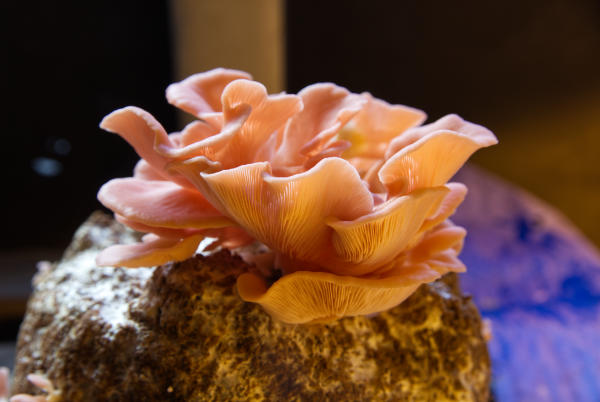
Oyster mushrooms were covered in the section above. It is important to note that they can also be found in the wild and foraged. The oyster mushroom is one of the easiest mushrooms to identify, and they have no poisonous look-alikes, so they are generally safe to harvest for those new to mushroom foraging.
It is important to note that you can also grow oyster mushrooms you find in the wild. I recently found a specimen of a common brown oyster growing on the Lost in the Ozarks property. I was able to get a tissue culture and now I have a liquid culture to expand and grow this variety of edible mushrooms.
You will find oyster mushrooms growing on dead or dying hardwood trees. Although one common species of oyster mushrooms can grow on conifer trees. This is the phoenix, or Italian oyster (Pleurotus pulmonarius).
Shaggy Mane
Shaggy Mane mushrooms (Coprinus comatus) are an edible mushroom species that are widely found in many parts of the world. They are small to medium in size, usually no more than 4 inches in diameter, and have a distinctive shaggy, white cap. Shaggy Mane mushrooms are a popular choice for foragers due to their unique flavor and texture.
Shaggy Mane mushrooms are most commonly found growing in areas with plenty of moisture, such as grassy fields, wooded areas, and meadows. They typically fruit in the late summer and fall months but can be found throughout the year in warmer climates. They are often found growing in clusters, which makes them relatively easy to spot.
There are two main types of Shaggy Mane mushrooms: the white variety, which is the most commonly found, and the black variety. The white variety has a white cap that is covered in delicate, woolly-looking scales. The black variety has a black cap with a similar texture. Both varieties have short, thick stems and white gills.
Shaggy Mane mushrooms have a mild, nutty flavor and a pleasant texture. They are often used in salads, soups, and stews. They can also be dried and stored for later use. Shaggy Mane mushrooms are a great choice for mushroom hunters, as they are relatively easy to identify and are widely available. With proper identification and careful preparation, they can be a delicious addition to any meal.
Hedgehog Mushroom
The Hedgehog Mushroom (Hydnum repandum) is a common species of mushroom found throughout North America and Europe. It is a type of edible mushroom that is prized for its flavor, texture, and unique shape.
Hedgehog mushrooms are generally found in wooded areas, particularly near coniferous and hardwood trees like birch, beech, and spruce. They grow in clusters in the form of brackets, and the caps are generally light yellow to orange in color. The spines underneath the cap are white when young, turning brown as the mushroom matures.
Hedgehog mushrooms are a great culinary addition to any dish. They can be used as a flavorful addition to soups and stews, as an ingredient for risotto, or as part of a vegetarian stir fry. They also make a great accompaniment to poultry or fish dishes.
Foragers should be aware that several poisonous species of mushrooms could be mistaken for the Hedgehog Mushroom. However, there are a few characteristics that distinguish this species from other lookalikes. The Hedgehog Mushroom has a cap with small spines that point downward and a white spore print. It also has a slightly sweet odor that can be detected after it has been picked. When harvesting Hedgehog Mushrooms, it is important to only pick those that are firm and not dried out. It is also important to properly clean and prepare the mushrooms before consuming them.
Puffball
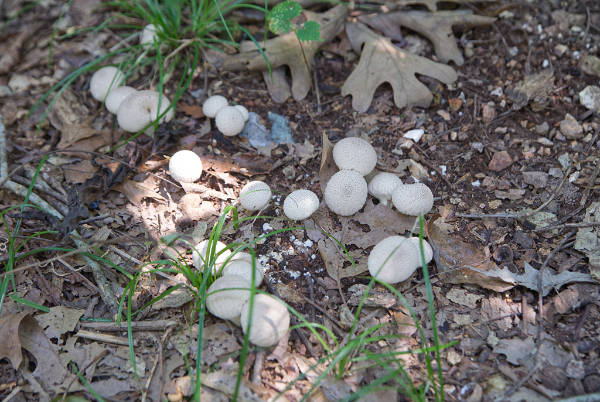
Puffball mushrooms (Lycoperdon spp.), are a type of mushroom belonging to the Lycoperdaceae family. They are found worldwide and are characterized by their round, globe-shaped fruiting bodies, which can range in size from 1 cm to over 20 cm in diameter. The most common species of puffball mushroom is the Lycoperdon perlatum, or common puffball.
The exterior of a puffball mushroom is typically white, tan, or grey and covered with a network of small bumps. As they mature, they may become browner in color and develop cracks in the surface. When cut open, the interior should be hollow and white, with a spongy texture. If the interior is yellow, brown, or pink, it has gone past its edible stage and should not be consumed.
They have a mild, nutty flavor and are a popular ingredient in soups, sauces, and other mushroom dishes. They can also be dried and powdered to use as a seasoning or thickener. There are many different types of puffball mushrooms, including the Giant Puffball (Calvatia gigantea), the Banded Puffball (Lycoperdon perlatum), the Earthstar (Geastrum spp.), and the Devil’s Urn (Urnula craterium). All of these mushrooms can be found in wooded areas, grassy fields, and other moist environments.
In addition to edible varieties, several inedible species of puffball mushrooms can be mistaken for edible ones. These include the False Puffball (Lycoperdon marginatum), the Stalked Puffball (Lycoperdon pyriforme), and the Spiny Puffball (Lycoperdon echinatum). Puffball mushrooms can be a great addition to any meal, but foraging for them should only be done with caution. It is always best to consult a local mushroom expert or foraging guide before harvesting any fungi from the wild.
Chicken of the Woods
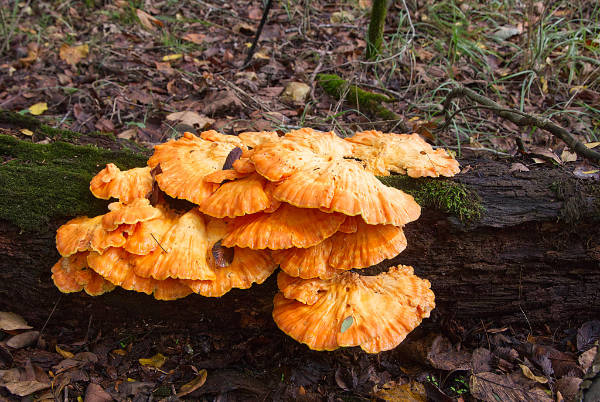
Chicken of the Woods (Laetiporus sulphureus) mushrooms can be found growing on dead or dying trees and logs, typically oak or hardwood species, in North America, Europe, and Asia. They are also known as sulfur-shelf mushrooms, chicken fungus, and chicken mushrooms. These mushrooms have a bright, yellow-orange color and a frilly, fan-like shape. They are usually between 4-20 inches in diameter and have an incredibly meaty texture.
Chicken of the Woods mushrooms have a variety of culinary uses. They are great cooked on their own or added to soups, stews, and other dishes. They have a flavor similar to that of chicken, hence their name.
There are two main varieties of Chicken of the Woods mushrooms: Laetiporus sulphureus and Laetiporus cincinnatus. Laetiporus sulphureus is the most common variety and can be found throughout North America, Europe, and Asia. It is distinguished by its yellow-orange color and fan-like shape. Laetiporus cincinnatus is found primarily in the Midwest United States and has a more rounded shape.
When foraging for Chicken of the Woods mushrooms, it is important to be sure of the identification and ensure that the mushrooms are not growing on any toxic trees or logs. It is also important to note that Chicken of the Woods mushrooms can be toxic if they are consumed raw.
Hen of the Woods
Hen of the Woods mushrooms, also known as Maitake mushrooms, are a type of medicinal mushroom native to North America and parts of Europe. They are prized for their unique flavor and are often used in Asian cuisine.
Hen of the Woods mushrooms are also known to have medicinal properties and are believed to have anti-cancer, anti-inflammatory, and immune-boosting properties. Hen of the Woods mushrooms, also known as Grifola frondosa, is a large, shelf-like mushroom that grows in clusters on decaying tree stumps or logs. They range in color from white to gray to brown and can be up to twenty inches in diameter. The mushrooms have a distinctive, earthy flavor and are often used in stir-fries, soups, stews, and sauces.
There are two main types of Hen of the Woods mushrooms. The first is the White Feather variety, which is found in the eastern United States in deciduous forests. These mushrooms have a milder flavor than the other varieties and are often used in salads and as a topping for pizza. The second type of Hen of the Woods mushroom is the Gray Feather variety, which is found in the western United States and Canada. These mushrooms have a stronger flavor and are often used in soups and stews.
Hen of the Woods mushrooms can be found in specialty grocery stores, health food stores, and farmers’ markets. They should be stored in a cool, dark place and should be used within a few days of purchase.
Conclusion
In conclusion, there is no doubt that edible mushrooms are an incredibly versatile and nutritious food. With over 3,000 species across the globe, edible mushrooms come in a wide variety of sizes, shapes, and colors. From the mild-flavored oyster mushroom to the hearty and flavorful portobello, there is a perfect mushroom for any dish. Not only are they delicious, but they also offer a wealth of health benefits. Rich in fiber and low in calories, they are an excellent source of vitamins, minerals, and antioxidants. Eating mushrooms may help boost immunity, protect against cancer, reduce inflammation, and improve heart health. Whether you choose to cook them, eat them raw, or add them to your favorite dishes, edible mushrooms are a nutritious and delicious addition to any diet.
For more articles about the health benefits of natural plants be sure and check out our blog.
FAQs:
White Button Mushrooms:
Q: What are white button mushrooms and what potential health benefits do they offer?
A: White button mushrooms are the most commonly consumed mushrooms in the United States. They are a good source of various vitamins and minerals, including vitamin D, copper, and potassium. They also contain beta-glucans and other polysaccharides, which may have immune-boosting effects.
Crimini Mushrooms:
Q: What are crimini mushrooms and what potential health benefits do they offer?
A: Crimini mushrooms are similar in appearance to white button mushrooms but have a darker brown color and a slightly richer flavor. They are a good source of B vitamins, selenium, and copper. They also contain ergothioneine, a potent antioxidant that may help protect cells from oxidative damage.
Portabella Mushrooms:
Q: What are portabella mushrooms and what potential health benefits do they offer?
A: Portabella mushrooms are a larger, more mature version of the crimini mushroom. They have a meaty texture and a rich umami flavor. Portabella mushrooms are a good source of potassium, phosphorus, and selenium. They also contain conjugated linoleic acid (CLA), a type of fatty acid that may have anti-inflammatory and anti-cancer properties.
Shiitake Mushrooms:
Q: What are shiitake mushrooms and what potential health benefits do they offer?
A: Shiitake mushrooms are a popular mushroom in Asian cuisine and have a rich, savory flavor. They are a good source of B vitamins, copper, and selenium. They also contain beta-glucans and other polysaccharides, which may have immune-boosting effects. Additionally, shiitake mushrooms contain lentinan, a type of polysaccharide that may have anti-cancer properties.
Oyster Mushrooms:
Q: What are oyster mushrooms and what potential health benefits do they offer?
A: Oyster mushrooms have a delicate texture and a mild, nutty flavor. They are a good source of B vitamins, copper, and potassium. They also contain ergothioneine, a potent antioxidant that may help protect cells from oxidative damage. Additionally, oyster mushrooms may have prebiotic effects, which means they can help promote the growth of beneficial gut bacteria.
Lion’s Mane Mushrooms:
Q: What are lion’s mane mushrooms and what potential health benefits do they offer?
A: Lion’s mane mushrooms have a unique, fluffy texture and a sweet, nutty flavor. They are a good source of B vitamins, copper, and potassium. They also contain hericenones and erinacines, bioactive compounds that may have neuroprotective and cognitive-enhancing effects.
Types of Mushrooms You Can Forage:
Morel (Morchella sp.):
Q: What are morel mushrooms and what potential health benefits do they offer?
A: Morel mushrooms are highly prized, wild mushrooms with a distinctive, honeycomb-like cap. They are a good source of various vitamins and minerals, including B vitamins, iron, and copper. Morel mushrooms also contain antioxidants and other bioactive compounds that may have anti-inflammatory and immune-boosting effects.
Chanterelle:
Q: What are chanterelle mushrooms and what potential health benefits do they offer?
A: Chanterelle mushrooms have a bright, golden color and a delicate, fruity flavor. They are a good source of various vitamins and minerals, including B vitamins, potassium, and copper. Chanterelle mushrooms also contain antioxidants and other bioactive compounds that may have anti-inflammatory and immune-boosting effects.
Q: Is it safe to forage for mushrooms?
A: Foraging for mushrooms can be safe and enjoyable, but it’s essential to properly identify the mushrooms before eating them, as some wild mushrooms can be poisonous. It’s also vital to forage in areas that are free from pollution and contamination.